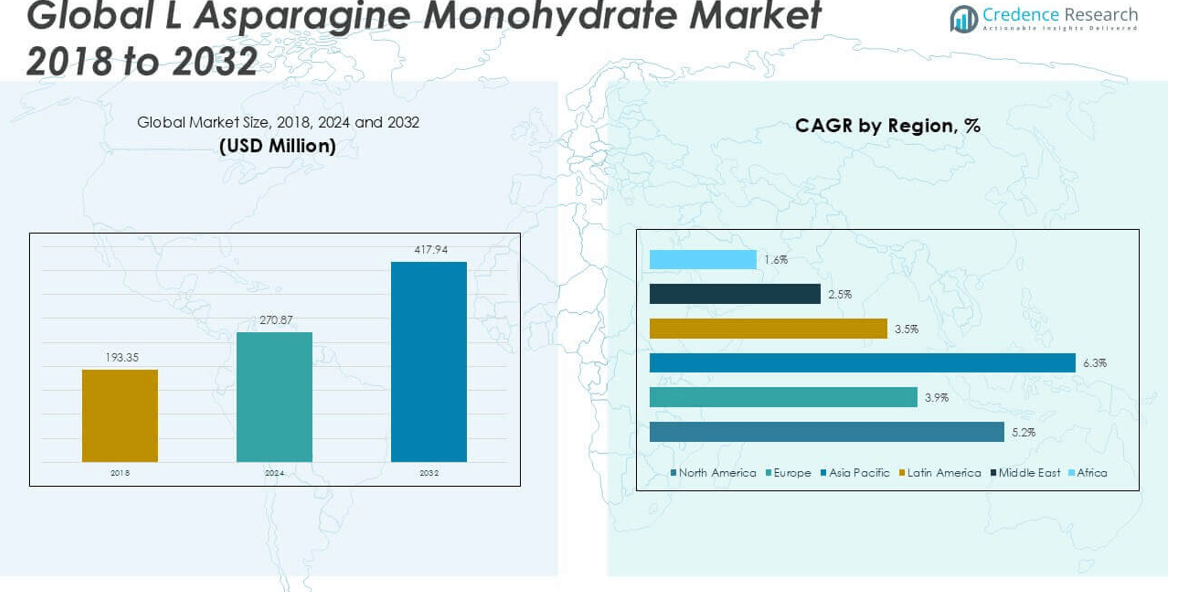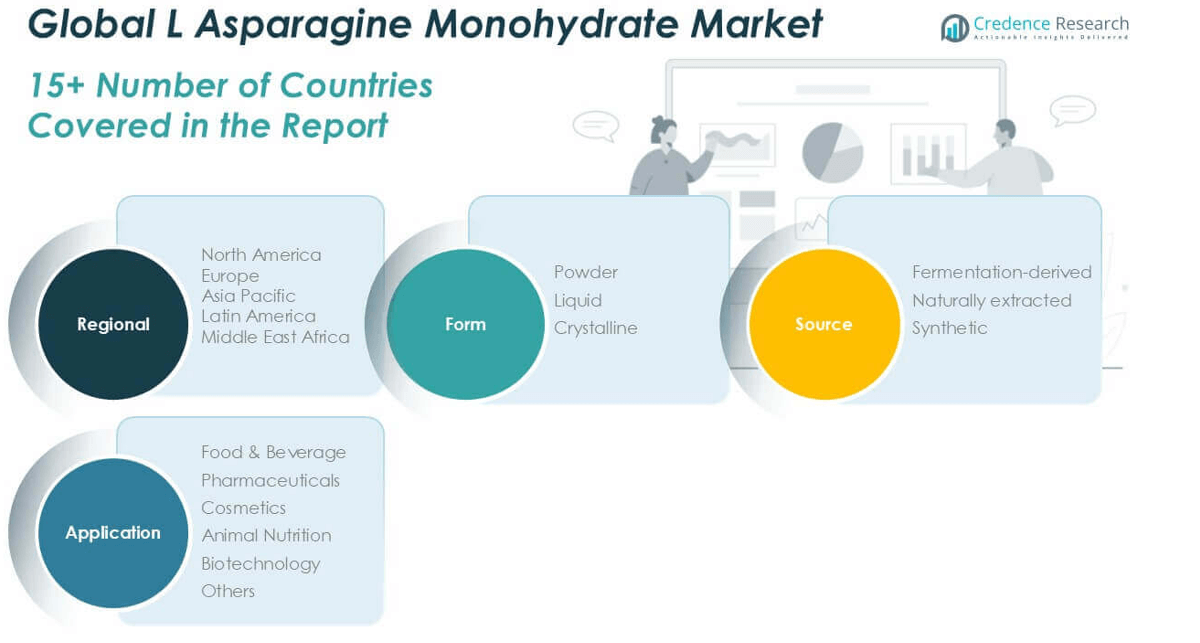CHAPTER NO. 1 : GENESIS OF THE MARKET
1.1 Market Prelude – Introduction & Scope
1.2 The Big Picture – Objectives & Vision
1.3 Strategic Edge – Unique Value Proposition
1.4 Stakeholder Compass – Key Beneficiaries
CHAPTER NO. 2 : EXECUTIVE LENS
2.1 Pulse of the Industry – Market Snapshot
2.2 Growth Arc – Revenue Projections (USD Million)
2.3. Premium Insights – Based on Primary Interviews
CHAPTER NO. 3 : L ASPARAGINE MONOHYDRATE MARKET FORCES & INDUSTRY PULSE
3.1 Foundations of Change – Market Overview
3.2 Catalysts of Expansion – Key Market Drivers
3.2.1 Momentum Boosters – Growth Triggers
3.2.2 Innovation Fuel – Disruptive Technologies
3.3 Headwinds & Crosswinds – Market Restraints
3.3.1 Regulatory Tides – Compliance Challenges
3.3.2 Economic Frictions – Inflationary Pressures
3.4 Untapped Horizons – Growth Potential & Opportunities
3.5 Strategic Navigation – Industry Frameworks
3.5.1 Market Equilibrium – Porter’s Five Forces
3.5.2 Ecosystem Dynamics – Value Chain Analysis
3.5.3 Macro Forces – PESTEL Breakdown
3.6 Price Trend Analysis
3.6.1 Regional Price Trend
3.6.2 Price Trend by Product
CHAPTER NO. 4 : KEY INVESTMENT EPICENTER
4.1 Regional Goldmines – High-Growth Geographies
4.2 Product Frontiers – Lucrative Product Categories
4.3 Application Sweet Spots – Emerging Demand Segments
CHAPTER NO. 5: REVENUE TRAJECTORY & WEALTH MAPPING
5.1 Momentum Metrics – Forecast & Growth Curves
5.2 Regional Revenue Footprint – Market Share Insights
5.3 Segmental Wealth Flow – Form & Source Revenue
CHAPTER NO. 6 : TRADE & COMMERCE ANALYSIS
6.1. Import Analysis by Region
6.1.1. Global L Asparagine Monohydrate Market Import Volume By Region
6.2. Export Analysis by Region
6.2.1. Global L Asparagine Monohydrate Market Export Volume By Region
CHAPTER NO. 7 : COMPETITION ANALYSIS
7.1. Company Market Share Analysis
7.1.1. Global L Asparagine Monohydrate Market: Company Market Share
7.1. Global L Asparagine Monohydrate Market Company Volume Market Share
7.2. Global L Asparagine Monohydrate Market Company Revenue Market Share
7.3. Strategic Developments
7.3.1. Acquisitions & Mergers
7.3.2. New Product Launch
7.3.3. Regional Expansion
7.4. Competitive Dashboard
7.5. Company Assessment Metrics, 2024
CHAPTER NO. 8 : L ASPARAGINE MONOHYDRATE MARKET – BY FORM SEGMENT ANALYSIS
8.1. L Asparagine Monohydrate Market Overview by Form Segment
8.1.1. L Asparagine Monohydrate Market Volume Share By Form
8.1.2. L Asparagine Monohydrate Market Revenue Share By Form
8.2. Powder
8.3. Liquid
8.4. Crystalline
CHAPTER NO. 9 : L ASPARAGINE MONOHYDRATE MARKET – BY SOURCE SEGMENT ANALYSIS
9.1. L Asparagine Monohydrate Market Overview by Source Segment
9.1.1. L Asparagine Monohydrate Market Volume Share By Source
9.1.2. L Asparagine Monohydrate Market Revenue Share By Source
9.2. Fermentation-derived
9.3. Naturally extracted
9.4. Synthetic
CHAPTER NO. 10 : L ASPARAGINE MONOHYDRATE MARKET – BY APPLICATION SEGMENT ANALYSIS
10.1. L Asparagine Monohydrate Market Overview by Application Segment
10.1.1. L Asparagine Monohydrate Market Volume Share By Application
10.1.2. L Asparagine Monohydrate Market Revenue Share By Application
10.2. Food & Beverage
10.3. Pharmaceuticals
10.4. Cosmetics
10.5. Animal Nutrition
10.6. Biotechnology
10.7. Others
CHAPTER NO. 11 : L ASPARAGINE MONOHYDRATE MARKET – REGIONAL ANALYSIS
11.1. L Asparagine Monohydrate Market Overview by Region Segment
11.1.1. Global L Asparagine Monohydrate Market Volume Share By Region
11.1.2. Global L Asparagine Monohydrate Market Revenue Share By Region
11.1.3. Regions
11.1.4. Global L Asparagine Monohydrate Market Volume By Region
11.1.5. Global L Asparagine Monohydrate Market Revenue By Region
11.1.6. Form
11.1.7. Global L Asparagine Monohydrate Market Volume By Form
11.1.8. Global L Asparagine Monohydrate Market Revenue By Form
11.1.9. Source
11.1.10. Global L Asparagine Monohydrate Market Volume By Source
11.1.11. Global L Asparagine Monohydrate Market Revenue By Source
11.1.12. Application
11.1.13. Global L Asparagine Monohydrate Market Volume By Application
11.1.14. Global L Asparagine Monohydrate Market Revenue By Application
CHAPTER NO. 12 : NORTH AMERICA L ASPARAGINE MONOHYDRATE MARKET – COUNTRY ANALYSIS
12.1. North America L Asparagine Monohydrate Market Overview by Country Segment
12.1.1. North America L Asparagine Monohydrate Market Volume Share By Region
12.1.2. North America L Asparagine Monohydrate Market Revenue Share By Region
12.2. North America
12.2.1. North America L Asparagine Monohydrate Market Volume By Country
12.2.2. North America L Asparagine Monohydrate Market Revenue By Country
12.2.3. Form
12.2.4. North America L Asparagine Monohydrate Market Volume By Form
12.2.5. North America L Asparagine Monohydrate Market Revenue By Form
12.2.6. Source
12.2.7. North America L Asparagine Monohydrate Market Volume By Source
12.2.8. North America L Asparagine Monohydrate Market Revenue By Source
12.2.9. Application
12.2.10. North America L Asparagine Monohydrate Market Volume By Application
12.2.11. North America L Asparagine Monohydrate Market Revenue By Application
12.3. U.S.
12.4. Canada
12.5. Mexico
CHAPTER NO. 13 : EUROPE L ASPARAGINE MONOHYDRATE MARKET – COUNTRY ANALYSIS
13.1. Europe L Asparagine Monohydrate Market Overview by Country Segment
13.1.1. Europe L Asparagine Monohydrate Market Volume Share By Region
13.1.2. Europe L Asparagine Monohydrate Market Revenue Share By Region
13.2. Europe
13.2.1. Europe L Asparagine Monohydrate Market Volume By Country
13.2.2. Europe L Asparagine Monohydrate Market Revenue By Country
13.2.3. Form
13.2.4. Europe L Asparagine Monohydrate Market Volume By Form
13.2.5. Europe L Asparagine Monohydrate Market Revenue By Form
13.2.6. Source
13.2.7. Europe L Asparagine Monohydrate Market Volume By Source
13.2.8. Europe L Asparagine Monohydrate Market Revenue By Source
13.2.9. Application
13.2.10. Europe L Asparagine Monohydrate Market Volume By Application
13.2.11. Europe L Asparagine Monohydrate Market Revenue By Application
13.3. UK
13.4. France
13.5. Germany
13.6. Italy
13.7. Spain
13.8. Russia
13.9. Rest of Europe
CHAPTER NO. 14 : ASIA PACIFIC L ASPARAGINE MONOHYDRATE MARKET – COUNTRY ANALYSIS
14.1. Asia Pacific L Asparagine Monohydrate Market Overview by Country Segment
14.1.1. Asia Pacific L Asparagine Monohydrate Market Volume Share By Region
14.1.2. Asia Pacific L Asparagine Monohydrate Market Revenue Share By Region
14.2. Asia Pacific
14.2.1. Asia Pacific L Asparagine Monohydrate Market Volume By Country
14.2.2. Asia Pacific L Asparagine Monohydrate Market Revenue By Country
14.2.3. Form
14.2.4. Asia Pacific L Asparagine Monohydrate Market Volume By Form
14.2.5. Asia Pacific L Asparagine Monohydrate Market Revenue By Form
14.2.6. Source
14.2.7. Asia Pacific L Asparagine Monohydrate Market Volume By Source
14.2.8. Asia Pacific L Asparagine Monohydrate Market Revenue By Source
14.2.9. Application
14.2.10. Asia Pacific L Asparagine Monohydrate Market Volume By Application
14.2.11. Asia Pacific L Asparagine Monohydrate Market Revenue By Application
14.3. China
14.4. Japan
14.5. South Korea
14.6. India
14.7. Australia
14.8. Southeast Asia
14.9. Rest of Asia Pacific
CHAPTER NO. 15 : LATIN AMERICA L ASPARAGINE MONOHYDRATE MARKET – COUNTRY ANALYSIS
15.1. Latin America L Asparagine Monohydrate Market Overview by Country Segment
15.1.1. Latin America L Asparagine Monohydrate Market Volume Share By Region
15.1.2. Latin America L Asparagine Monohydrate Market Revenue Share By Region
15.2. Latin America
15.2.1. Latin America L Asparagine Monohydrate Market Volume By Country
15.2.2. Latin America L Asparagine Monohydrate Market Revenue By Country
15.2.3. Form
15.2.4. Latin America L Asparagine Monohydrate Market Volume By Form
15.2.5. Latin America L Asparagine Monohydrate Market Revenue By Form
15.2.6. Source
15.2.7. Latin America L Asparagine Monohydrate Market Volume By Source
15.2.8. Latin America L Asparagine Monohydrate Market Revenue By Source
15.2.9. Application
15.2.10. Latin America L Asparagine Monohydrate Market Volume By Application
15.2.11. Latin America L Asparagine Monohydrate Market Revenue By Application
15.3. Brazil
15.4. Argentina
15.5. Rest of Latin America
CHAPTER NO. 16 : MIDDLE EAST L ASPARAGINE MONOHYDRATE MARKET – COUNTRY ANALYSIS
16.1. Middle East L Asparagine Monohydrate Market Overview by Country Segment
16.1.1. Middle East L Asparagine Monohydrate Market Volume Share By Region
16.1.2. Middle East L Asparagine Monohydrate Market Revenue Share By Region
16.2. Middle East
16.2.1. Middle East L Asparagine Monohydrate Market Volume By Country
16.2.2. Middle East L Asparagine Monohydrate Market Revenue By Country
16.2.3. Form
16.2.4. Middle East L Asparagine Monohydrate Market Volume By Form
16.2.5. Middle East L Asparagine Monohydrate Market Revenue By Form
16.2.6. Source
16.2.7. Middle East L Asparagine Monohydrate Market Volume By Source
16.2.8. Middle East L Asparagine Monohydrate Market Revenue By Source
16.2.9. Application
16.2.10. Middle East L Asparagine Monohydrate Market Volume By Application
16.2.11. Middle East L Asparagine Monohydrate Market Revenue By Application
16.3. GCC Countries
16.4. Israel
16.5. Turkey
16.6. Rest of Middle East
CHAPTER NO. 17 : AFRICA L ASPARAGINE MONOHYDRATE MARKET – COUNTRY ANALYSIS
17.1. Africa L Asparagine Monohydrate Market Overview by Country Segment
17.1.1. Africa L Asparagine Monohydrate Market Volume Share By Region
17.1.2. Africa L Asparagine Monohydrate Market Revenue Share By Region
17.2. Africa
17.2.1. Africa L Asparagine Monohydrate Market Volume By Country
17.2.2. Africa L Asparagine Monohydrate Market Revenue By Country
17.2.3. Form
17.2.4. Africa L Asparagine Monohydrate Market Volume By Form
17.2.5. Africa L Asparagine Monohydrate Market Revenue By Form
17.2.6. Source
17.2.7. Africa L Asparagine Monohydrate Market Volume By Source
17.2.8. Africa L Asparagine Monohydrate Market Revenue By Source
17.2.9. Application
17.2.10. Africa L Asparagine Monohydrate Market Volume By Application
17.2.11. Africa L Asparagine Monohydrate Market Revenue By Application
17.3. South Africa
17.4. Egypt
17.5. Rest of Africa
CHAPTER NO. 18 : COMPANY PROFILES
18.1. Ajinomoto Co., Inc.
18.1.1. Company Overview
18.1.2. Product Portfolio
18.1.3. Financial Overview
18.1.4. Recent Developments
18.1.5. Growth Strategy
18.1.6. SWOT Analysis
18.2. Merck KGaA (Sigma-Aldrich)
18.3. Tokyo Chemical Industry Co., Ltd. (TCI)
18.4. Evonik Industries AG
18.5. Alfa Aesar (Thermo Fisher Scientific)
18.6. Angene International Limited
18.7. Wuhan Amino Acid Bio-Chemical Co., Ltd.
18.8. Shanghai Bojing Chemical Co., Ltd.
18.9. Shijiazhuang Jirong Pharmaceutical Co., Ltd.
18.10. Sisco Research Laboratories Pvt. Ltd.









